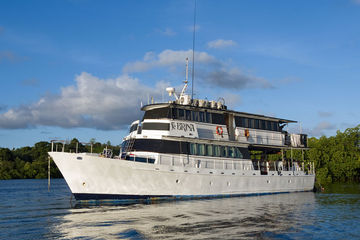Popular Witu Islands liveaboards Explore all liveaboards
Liveaboard Diving in Witu Islands
What To Expect On a Witu Islands Liveaboard
Liveaboards in the Witu Islands sail six hours northwest from Walindi in Kimbe Bay on the coast of New Britain, to take divers to explore a remote group of isles that are the remnants of ancient, collapsed volcanic craters. Situated about 100 km (65 miles) out from mainland Papua New Guinea in the Bismarck Sea, the Witu group consists of the four main islands of Garove, Narage, Unea and Mundua, where plankton-rich Pacific ocean currents host an abundance of sea life and create a diving area celebrated for its big fish action.
The largest island, Garove, offers sheltered anchorages along the shoreline of the old caldera that varies from rocky slopes and low cliffs to sandy beaches, often with vegetation growing right down to the ocean's edge.
With strikingly good visibility, liveaboard diving in Witu, these South Sea Islands that have been seemingly forgotten by the 21st century, will satisfy both macro enthusiasts and pelagic stalkers.
Witu Islands Underwater
Scuba diving in the Witu Islands you'll discover pinnacles and outlying reefs enveloped with gardens of hard coral, brilliantly colored soft corals, and every shape and hue of anemone along with their resident clownfish. Macro diving can unearth Nudibranchs, Harlequin shrimp, Peacock Mantis Shrimp, Ribbon eels, and pipefish among the many strange and wonderful creatures on display. But for many diving here, attentions are focused out in the clear blue waters where the stage is flooded with churning schools of trevally, tuna, and barracuda, while a variety of sharks patrol the drop-offs in the currents that sweep the islands.
Dive Sites Of Witu Islands
Dickie's Place at Garove Island is a favorite site of liveaboards. Named after the late Dickie Doyle, a much-loved character who lived in the Witu Islands most of his life, a large bommie rises from the dark blue waters of the deep to within five meters (15 feet) of the surface. Pelagics populate the surrounding ocean currents, and the macro dives that please during the day get even better at night.
Krackafat (a.k.a. Lama Shoals) for many repeat visitors is one of the top diving spots in Papua New Guinea, and possibly the world. It's an impressive seamount the size of a football field, with seemingly infinite visibility, awash with nutrient-rich currents. In the blue water just above the coral crown huge swirls of schooling jacks and barracuda dwarf visiting divers.
Wiry Bay is ideal for a macro dive. Amazing contrast between the black volcanic sand and the unadulterated visibility offers the ideal diving conditions to view schools of Sand Divers soaring off the edge of the reef, while Signal Gobies, Peacock Mantis Shrimps and a very inquisitive Lionfish draw your attention.
Goru Arches is positioned on a coral ridge and boasts two large arches adorned with swaying sea fans and a multitude of soft corals. If you're lucky, a resident school of Bumphead Parrotfish patrols the area near their nighttime barracks while Batfish appear to hang around to pose for photos.
Liveaboard diving among these fantastically isolated islands and their deep-sea currents would not be complete without the chance to let yourself get carried away with the stream. Witu Drift is the perfect spot for this. A striking wall, shrouded in electric soft corals and barrel sponges, drops abruptly down to the sandy bottom below.
Top Tips For Divers
Underwater photographers will want to pack as many different lenses as they can, to be sure you have the perfect match for both macro and wide-angle subjects. And you can never have too many backup batteries, so you don't have to tussle for space at the charging station on board.
For your liveaboard in the Witu Islands you may need an adaptor to convert the plugs on your electronics to fit Australian/New Zealand sockets (240V/50hz electricity), although some liveaboard boats are fitted with both 110V and 220V outlets for recharging batteries on board, so check with your chosen dive boat.
Be smart with your packing as domestic PNG flights can be rather strict on checked-baggage weight limits. That said, some of the airlines give additional allowances especially for dive gear, above and beyond your other bags, it's a good idea to check into this before booking local flights, as excess bag fees can be rather painful.
Getting To Witu Islands
A dive cruise is the best way to discover the wonders of this isolated island group, and with no people, ports of landing strips on these rugged volcanic outcrops, liveaboard boats are also the only way to get there.
To embark on your scuba diving adventure, you'll fly into Jackson's International Airport just outside Port Moresby, Papua New Guinea's main entry point. Here you'll transfer to one of the local national airlines for the jump over to New Britain Island, where you'll hop aboard your liveaboard at the Walindi Plantation Resort.
Witu Islands Diving Reviews
- 9.2 Superb
- 1 Verified Reviews
The most memorable was a muckdive on black sands.
Diving Witu Islands in December on the Febrina








